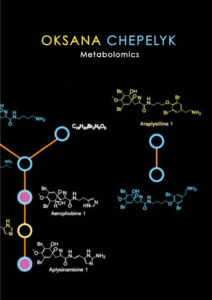
Credit: Timothée Andonian / Iméra
Oksana Chepelyk
Interview with Oksana Chepelyk,research residency at the Institute for Advanced Studies of Aix-Marseille University (Iméra) for the 2022-23 term (Fr)
Publications

Research project
“Analytical Instruments for Audio-Visual Translation of Metabolomics” merging genotype and environment regarding climate changes
Summary of the research project
Oksana Chepelyk’s research project at the Institute for advanced Study of Aix-Marseille University (Iméra) pursues eco-art and science-art projects within a broad experimentation at the crossroads of research and art practice, such as data-driven moving imagery, sonification, live cinema and data visualization in spatial structure, and modelling. This work derives from Oksana Chepelyk’s former residency at Iméra.
Oksana Chepelyk’s approach in realization of the project consists of the methodical theoretical search using library, archival research, interviews, video documentation іnvestigating:
– neomateriality and post-digital aesthetics;
– data visualization and immersive environments;
– techno-ecological perspective.
The science-art will be researched as a contemporary art trend with focus on sonification and visual representation of scientific data of metabolomics. Historical reference from Varese and Xenakis’ approach in the musical tradition, from Leonardo to Xenakis in the visual direction toward our time with the help of AI machine learning technology will be taken as a starting point of research.
Using characteristics of NMR – Nuclear Magnetic Resonance spectroscopy and mass spectrometry methodology a different spin on NMR the project could approach audio-visual representation, but the technique doesn’t make most chemists think of music, or colors.
Molecular Sonification, namely the encoding of molecules as music, is particularly intriguing since the multiple dimensions of music can allow encoding of many molecular properties.
An explosion of AI methods in the study and creation leads to the prospects of merging modern chemistry machine learning (ML) techniques with recent ML techniques for visual and ML techniques for music.
In this project Oksana Chepelyk will introduce a few aspects of the complex research and field work thatshe tries to contribute to, placing interdisciplinarity at the service of ecological and environmental purposes. As it also refers to a purely scientific combination of experimental ecology and next-generation -omics technologies (including genomics, epigenomics, transcriptomics and metabolomics) that represent an unprecedented opportunity to characterize the patterns of local adaptation and phenotypic plasticity in natural systems and, ultimately, to understand the complex relationships between phenotype, genotype and environment in the context of climate change. In the face of climate change, Chepelyk’s approach to this research using sonography and translation of complex biochemical events into visual liquid AI summoning elements will serve as an argument for fundamental knowledge, but it will also provide information for the sustainable management of our vulnerable ecosystems.
Biography
Dr. Oksana Chepelyk is a leading researcher of the New Technologies Department, Modern Art Research Institute of Ukraine, Associate Professor of the National Academy of Fine Arts and Architecture in Kyiv, film director of the Ukrainian Documentary Film Studio, author of book The Interaction of Architectural Spaces, Contemporary Art and New Technologies (2009) and since 2007 a curator of International Festival of Social Sculpture, Kyiv. Oksana studied art in Kyiv, followed PhD course, Moscow, Amsterdam University, Banff Centre, Canada, Bauhaus Dessau, Germany, twice 2003-2004, 2010-2011 Fulbright Research Program at UCLA, USA. Awards: ArtsLink1997/2007 Award (USA), FilmVideo99 (Italy), EMAF2003 Werklietz Award 2003 (Germany), Cinemadamare Award 2013, Venice International Film Festival, Final Cut, (Italy), Artraker Award2013 (UK), Best Project2018 (Taiwan), State of the ART(ist) AWARD, Ars Electronica 2022, Linz, (Austria). Works shown: MOMA, NY; MMA, Zagreb; German Historical Museum, Berlin and Munich; Museum of the Arts History, Vienna; MCA, Skopje; MJT, LA; Art Arsenal Museum, Kyiv; “DIGITAL MEDIA Valencia”, Spain; MACZUL, Maracaibo, Venezuela, “The File”, Sao Paolo; 2015 – “Borderline. Ukrainian Art 1985-2004”, PinchukArtCentre, Kyiv; “The WOW: The-Refugee-Memorial”, The New Museum of Networked Art, Los Angeles, USA; LPM-2016/2017 Amsterdam; “Anonymous Society”, PinchukArtCentre, Kyiv; 2018 “Flashback. Ukrainian art of the 90th”, Art Arsenal National Museum Complex, Kyiv, Ukraine (catalogue); Kuandu Museum, Taipei, Taiwan; Gallery A 13, Soulangh Cultural Park Tainan, Taiwan (Best Project2018); “A Space of On’s Own”, PinchukArtCentre, Kyiv ; TiFF 2018, Tainan International Foto Festival, Gallery A4, Soulangh Cultural Park, Tainan, Taiwan; 2019 Ukrainian Pavilion, Arsenal, Venice Biennale, Italy; “Insatiable Mind”, Salisbury International Art Festival, Art Centre, Salisbury, UK; 2020 “Art + Feminism 2020”, Spazju Kreativ, Valletta, Malta; MADATAC-2020, Madrid, Spain; 2021 “Refraction of Reality”, The Korsaks Museum of Contemporary Ukrainian Art, Lutsk, Ukraine; Ukrainian Biennale of Digital and Media Art, Artarea, Kyiv, Ukraine; 2022 EDAF-2022, “Retrospective: Oksana Chepelyk”, Torance Art Museum, Los Angeles, USA; “Manifesta 14”, Prishtina, Kosovo; Ars Electronica 2022, Linz, Austria.



